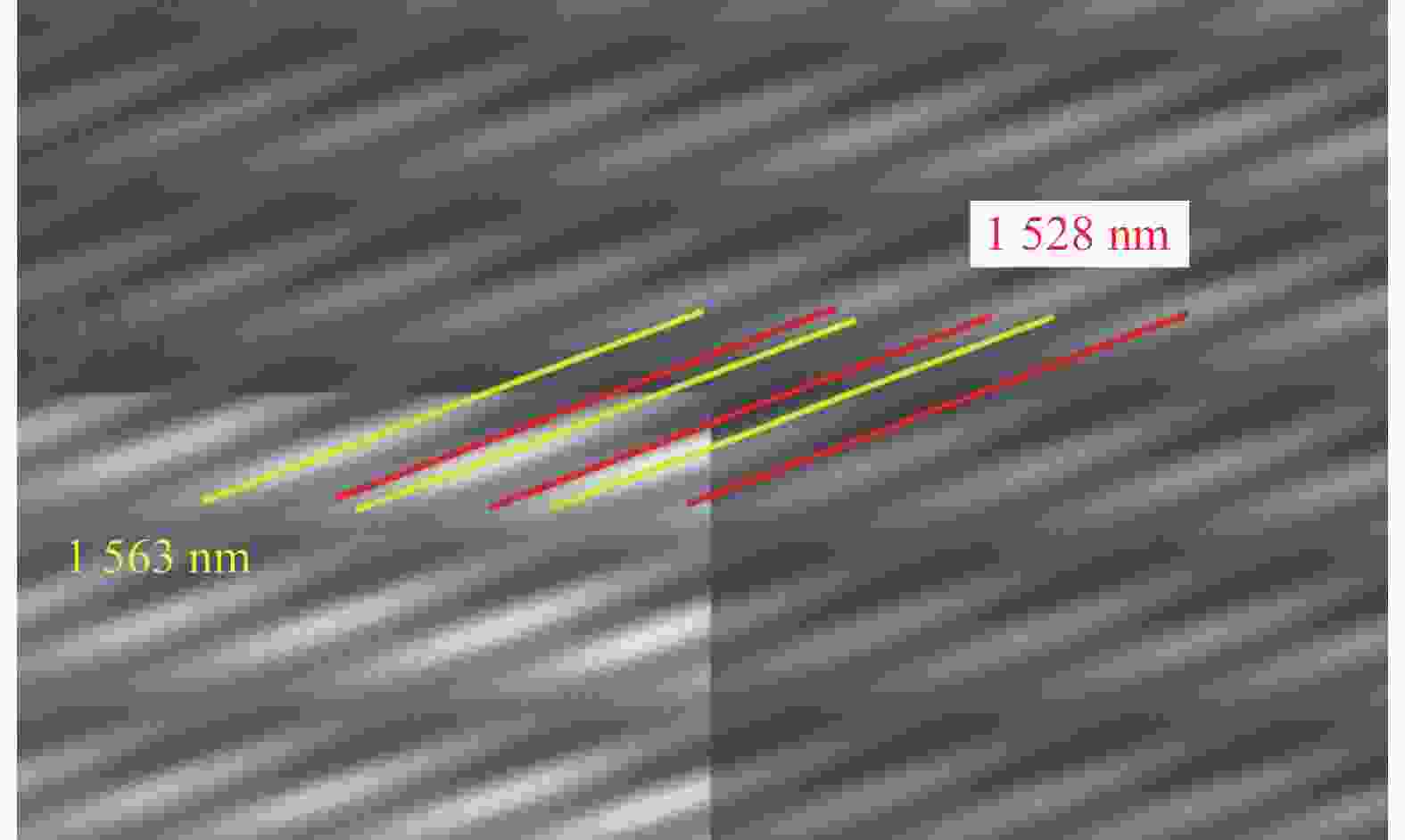Co-phasing method for sparse aperture optical systems based on multichannel fringe tracking
doi: 10.37188/CO.EN-2024-0002
-
摘要:
本文提出采用多通道条纹跟踪方法以实现大口径稀疏孔径望远镜的有效共相调整,该方法允许同时进行多个光路的干涉测量,避免了传统干涉方法中沿镜面边界进行成对测量的需要,从而提高了检测效率并降低了系统复杂性。使用光学波前理论分析了多光束干涉过程的原理和基于光纤直接连接的共相检测模块构造,并对通过多路径干涉获得的系统面型进行了误差分析,探索了干涉方法的潜在应用。最后,通过实验验证实现了原理贯通,通过平场校准和非相干数字合成,实现了优于0.4的干涉条纹对比度,并且动态测量范围优于工作中心波长(
1550 nm)的10倍以上,实现了比工作中心波长(1550 nm)更优的分辨率。实现三光束干涉的同时检测效率提高了50%,从而有效提高了稀疏孔径望远镜的共相效率,满足8~10 m望远镜的观测要求,为观察遥远和暗淡的天体提供了技术基础。Abstract:To realize effective co-phasing adjustment in large-aperture sparse-aperture telescopes, a multichannel stripe tracking approach is employed, allowing simultaneous interferometric measurements of multiple optical paths and circumventing the need for pairwise measurements along the mirror boundaries in traditional interferometric methods. This approach enhances detection efficiency and reduces system complexity. Here, the principles of the multibeam interference process and construction of a co-phasing detection module based on direct optical fiber connections were analyzed using wavefront optics theory. Error analysis was conducted on the system surface obtained through multipath interference. Potential applications of the interferometric method were explored. Finally, the principle was verified by experiment, an interferometric fringe contrast better than 0.4 is achieved through flat field calibration and incoherent digital synthesis. The dynamic range of the measurement exceeds 10 times of the center wavelength of the working band (
1550 nm). Moreover, a resolution better than one-tenth of the working center wavelength (1550 nm) was achieved. Simultaneous three-beam interference can be achieved, leading to a 50% improvement in detection efficiency. This method can effectively enhance the efficiency of sparse aperture telescope co-phasing, meeting the requirements for observations of 8–10 m telescopes. This study provides a technological foundation for observing distant and faint celestial objects. -
Figure 6. Validation results of the dual-wavelength fringe tracking. (a), (b) Interference fringes formed by the narrowband light at
1530 nm and their average cross-section; (c), (d) interference fringes formed by the narrowband light at1560 nm and their average cross-section; (e), (f) incoherent synthesis of the dual wavelength and average cross-section -
[1] SITARSKI B N, RAKICH A, CHIQUITO H, et al. The GMT telescope metrology system design[J]. Proceedings of the SPIE, 2022, 12182: 1218207. doi: 10.1117/12.2630598 [2] MCLEOD B A, BOUCHEZ A H, CATROPA D, et al. The wide field phasing testbed for the giant Magellan telescope[J]. Proceedings of the SPIE, 2022, 12182: 1218208. doi: 10.1117/12.2630588 [3] UMBRIACO G, VASSALLO D, FARINATO J, et al. Deformable lens for testing the performance of focal plane wavefront sensing using phase diversity[J]. Proceedings of the SPIE, 2022, 12185: 121856W. doi: 10.1117/12.2629385 [4] CATROPA D, MCLEOD B, D'ARCO J, et al. Piston-tip-tilt mirror array in the wide field phasing testbed for the giant Magellan telescope[J]. Proceedings of the SPIE, 2022, 12185: 121854I. doi: 10.1117/12.2630703 [5] DEMERS R, BOUCHEZ A, QUIRÓS-PACHECO F, et al. Phasing the segmented giant Magellan telescope: progress in testbeds and prototypes[J]. Proceedings of the SPIE, 2022, 12185: 1218518. doi: 10.1117/12.2630144 [6] YANG P Q, HIPPLER S, DEEN C P, et al. Characterization of the transmitted near-infrared wavefront error for the GRAVITY/VLTI Coudé infrared adaptive optics system[J]. Optics Express, 2013, 21(7): 9069-9080. doi: 10.1364/OE.21.009069 [7] BONNEFOIS A M, FUSCO T, MEIMON S, et al. Comparative theoretical and experimental study of a Shack-Hartmann and a phase diversity sensor, for high-precision wavefront sensing dedicated to space active optics[J]. Proceedings of the SPIE, 2017, 10563: 105634B. doi: 10.1117/12.2304263 [8] VOSTEEN L L A, DRAAISMA F, VAN WERKHOVEN W P, et al. Wavefront sensor for the ESA-GAIA mission[J]. Proceedings of the SPIE, 2009, 7439: 743914. doi: 10.1117/12.825240 [9] TRAUGER J, STAPELFELDT K, TRAUB W, et al. ACCESS: a NASA mission concept study of an actively corrected coronagraph for exoplanet system studies[J]. Proceedings of the SPIE, 2008, 7010: 701029. doi: 10.1117/12.789119 [10] LIOTARD A, BERNOT M, CARLAVAN M, et al. Wave-front sensing for space active optics: rascasse project[J]. Proceedings of the SPIE, 2017, 10563: 105632W. doi: 10.1117/12.2304111 [11] CHEFFOT A L, PLANTET C, PINNA E, et al. Differential piston sensing with LIFT: application to the GMT[J]. Proceedings of the SPIE, 2022, 12185: 1218557. doi: 10.1117/12.2630046 [12] HEDGLEN A D, CLOSE L M, HAFFERT S Y, et al. First lab results of segment/petal phasing with a pyramid wavefront sensor and a novel holographic dispersed fringe sensor (HDFS) from the giant Magellan telescope high contrast adaptive optics phasing testbed[J]. Proceedings of the SPIE, 2022, 12185: 1218516. doi: 10.1117/12.2629538 [13] WILHELM R, LUONG B, COURTEVILLE A, et al. Dual-wavelength low-coherence instantaneous phase-shifting interferometer to measure the shape of a segmented mirror with subnanometer precision[J]. Applied Optics, 2008, 47(29): 5473-5491. doi: 10.1364/AO.47.005473 [14] CODONA J L, DOBLE N. James Webb space telescope segment phasing using differential optical transfer functions[J]. Journal of Astronomical Telescopes, Instruments, and Systems, 2015, 1(2): 029001. doi: 10.1117/1.JATIS.1.2.029001 [15] ACTON D S, KNIGHT J S, CONTOS A, et al. Wavefront sensing and controls for the James Webb space telescope[J]. Proceedings of the SPIE, 2012, 8442: 84422H. doi: 10.1117/12.925015 [16] LI L L, ZHAO H T, LIU C, et al. Intelligent metasurfaces: control, communication and computing[J]. eLight, 2022, 2: 7. doi: 10.1186/s43593-022-00013-3 [17] LIU ZH, WANG SH Q, RAO CH H. The co-phasing detection method for sparse optical synthetic aperture systems[J]. Chinese Physics B, 2012, 21(6): 069501. doi: 10.1088/1674-1056/21/6/069501 [18] CHEN ZH G, SEGEV M. Highlighting photonics: looking into the next decade[J]. eLight, 2021, 1: 2. doi: 10.1186/s43593-021-00002-y [19] SIROHI R. Shearography and its applications—a chronological review[J]. Light: Advanced Manufacturing, 2022, 3(1): 35-64. doi: 10.37188/lam.2022.001 [20] AN Q CH, ZHANG H F, WU X X, et al. Photonics large-survey telescope internal motion metrology system[J]. Photonics, 2023, 10(5): 595. doi: 10.3390/photonics10050595 [21] EISENHAUER F, PERRIN G, STRAUBMEIER C, et al. GRAVITY: microarcsecond astrometry and deep interferometric imaging with the VLTI[J]. Proceedings of the International Astronomical Union, 2007, 3(S248): 100-101. doi: 10.1017/S1743921308018723 -






 下载:
下载:








